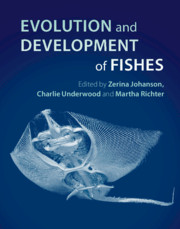Book contents
- Evolution and Development of Fishes
- Evolution and Development of Fishes
- Copyright page
- Contents
- Contributors
- Introduction
- 1 The Evolution of Fishes through Geological Time
- 2 Comparative Development of Cyclostomes
- 3 The Ordovician Enigma
- 4 The Evolution of Vertebrate Dermal Jaw Bones in the Light of Maxillate Placoderms
- 5 Doliodus and Pucapampellids
- 6 The Evolution of Endoskeletal Mineralisation in Chondrichthyan Fish
- 7 Plasticity and Variation of Skeletal Cells and Tissues and the Evolutionary Development of Actinopterygian Fishes
- 8 Origin, Development and Evolution of the Fish Skull
- 9 Evolution, Development and Regeneration of Fish Dentitions
- 10 Development of Head Muscles in Fishes and Notes on Phylogeny-Ontogeny Links
- 11 Evolutionary Development of the Postcranial and Appendicular Skeleton in Fishes
- 12 Evolution of Vertebrate Reproduction
- 13 Links between Thyroid Hormone Alterations and Developmental Changes in the Evolution of the Weberian Apparatus
- 14 Pharyngeal Remodelling in Vertebrate Evolution
- 15 Evolution of Air Breathing and Lung Distribution among Fossil Fishes
- Index
- References
4 - The Evolution of Vertebrate Dermal Jaw Bones in the Light of Maxillate Placoderms
Published online by Cambridge University Press: 31 December 2018
- Evolution and Development of Fishes
- Evolution and Development of Fishes
- Copyright page
- Contents
- Contributors
- Introduction
- 1 The Evolution of Fishes through Geological Time
- 2 Comparative Development of Cyclostomes
- 3 The Ordovician Enigma
- 4 The Evolution of Vertebrate Dermal Jaw Bones in the Light of Maxillate Placoderms
- 5 Doliodus and Pucapampellids
- 6 The Evolution of Endoskeletal Mineralisation in Chondrichthyan Fish
- 7 Plasticity and Variation of Skeletal Cells and Tissues and the Evolutionary Development of Actinopterygian Fishes
- 8 Origin, Development and Evolution of the Fish Skull
- 9 Evolution, Development and Regeneration of Fish Dentitions
- 10 Development of Head Muscles in Fishes and Notes on Phylogeny-Ontogeny Links
- 11 Evolutionary Development of the Postcranial and Appendicular Skeleton in Fishes
- 12 Evolution of Vertebrate Reproduction
- 13 Links between Thyroid Hormone Alterations and Developmental Changes in the Evolution of the Weberian Apparatus
- 14 Pharyngeal Remodelling in Vertebrate Evolution
- 15 Evolution of Air Breathing and Lung Distribution among Fossil Fishes
- Index
- References
Summary
Dermal skeletal components near the oral cavity, or dermal jaw bones, contribute to the integrated jaw structure from the beginning of gnathostome evolutionary history and have evolved to be the exclusive skeletal elements of the jaw in mammals, including humans. The morphological variations and modifications of these dermal jaw bones are pivotal in assessing their homology and reconstructing the evolutionary relationship of gnathostome groups. The recent discoveries of maxillate placoderms present unique insights into the evolution of osteichthyan dermal jaw bones, previously considered to be an autapomorphy of the Osteichthyes. Here we briefly review the dermal jaw bones in major gnathostome groups, with focus on taxa close to the transition from stem- to crown-group gnathostomes, i.e., various placoderm subgroups (including antiarchs, arthrodires, ptyctodonts, rhenanids) and basal osteichthyans. In particular, we present a detailed description of the dermal jaw components in the two maxillate placoderms, Entelognathus and Qilinyu. In light of the new morphological data and the comparison between these conditions, we propose the homology between the maxillate placoderm dermal jaw bones and arthrodire gnathal elements. Based on a review of character combinations in gnathostome subgroups, we also propose a possible evolutionary sequence of dermal jaw bones in early jawed vertebrates and demonstrate that the parasphenoid underwent substantial parallelism in placoderms and osteichthyans. We suggest that the inner position of gnathal plates in arthrodires might be secondary. The dermal jaw bones of eubrachythoracid arthrodires show adaptations comparable to those in osteichthyans, in addition to the better-known convergence of ptyctodonts and holocephalans.
- Type
- Chapter
- Information
- Evolution and Development of Fishes , pp. 71 - 86Publisher: Cambridge University PressPrint publication year: 2019
References
- 2
- Cited by

